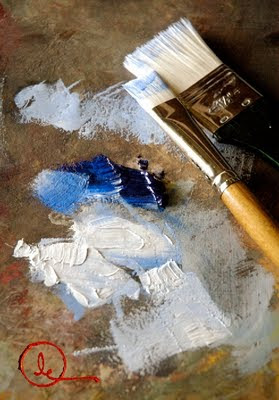An Artist's Eye
By Al R. Young
 |
| Photograph of Al's palette by Elspeth Young |
Factors such as media, individual style, techniques, available tools, and the messages (to borrow a term from communication theory) are major influences in how an artist approaches and completes each work. This includes the use of models, photographs, etc.
While some people hold to the idea that using photographs is somehow wrong, I am not one of them. I work from life as well as photographs, and I find that, at least in terms of the way I see and render, the use of photographs enhances the journey and improves the outcome. Much of the production of artwork (or anything, for that matter) requires the appropriate use of available tools for specific purposes at the right time during the creative process. I use photographs as one means of looking, not as a substitute for seeing.
My experience with still life is simply the necessity of being prepared to draw or paint "to the death." Either you "make it" in time, before the subject withers, or, like the old TV series about Lassie—you wind up with a kennel full of subjects contributing effectively to a good result.
As far as busy and expensive models are concerned, I prefer to search instead for models among the people of my acquaintance. Just as everyone is "ordinary," everyone is also "heroic," and I enjoy discovering and presenting the heroic in each of us. That is, in fact, a major part of what our artwork is all about anyway. My objective in presenting any subject in any medium is to convey something of what I know about it and how I feel about it, and to do so in a way that resonates in the mind and in the heart.
In my reading about creativity one of the most enduring ideas I have encountered is that for some people creativity often starts with a vague idea and involves a journey in which the creator discovers the nature of what is being created. For other people, the journey often starts with a very clear idea of the nature of the completed artifact, and the work of creativity consists in copying the inner vision. I do not know the extent to which this may be an accurate or true perspective, but I have found this to be a particularly useful idea. At the very least, the idea has provided reassurance, during my own creative efforts, that not to know precisely where they lead or how to get there is no reason to panic and may not even be a reason to quit. At the outset of any creative endeavor I find myself intrigued by something; something that wants expression. As I pursue the interest, striving all the while to complete the expression, the expression clarifies as it materializes.
Perceiving something, or seeing it, results from looking for it. Seeing, as one of my professors once described it, is a directed activity; something the mind does, not the eyes. I am also reminded of some things the American philosopher Susanne Langer once observed; insights that come close to the heart of the subject. Citing Felix Cohen, Langer declares:
A question is really an ambiguous proposition; the answer is its determination. There can be only a certain number of alternatives that will complete its sense. . . . .The limits of thought are not so much set from outside, by the fullness or poverty of experiences that meet the mind, as from within, by the power of conception, the wealth of formulative notions with which the mind meets experiences. Most new discoveries are suddenly-seen things that were always there. A new idea is a light that illuminates presences which simply had no form for us before the light fell on them. We turn the light here, there, and everywhere, and the limits of thought recede before it. . . . . If we would have new knowledge, we must get us a whole world of new questions. (Philosophy in a New Key: A Study in the Symbolism of Reason, Rite, and Art, pp. 4-13)As far as the creation of an artwork (in any medium) is concerned, the insight or freshness in the resulting artifact or expression depends first upon the questions the artist asks of what he or she sees and secondly upon cultivating the stamina and skill to complete the journey of its expression.
Tags: 2011, Tips and techniques
Browse articles by year: 2025 . 2024 . 2023 . 2022 . 2021 . 2020 . 2019 . 2018 . 2017 . 2016 . 2015 . 2014 . 2013 . 2012 . 2011 . 2010 . 2009 . 2008 . 2007 . 2006 . 2005 . 2004 . 2003 . 2002 . 2001 . 2000 . 1999 . 1998 . 1997 . 1996
Browse articles by topic: Art lessons . BenHaven Archives . Blank art diaries . Fine art photography . Framing . Illustration . Inspiration and creativity . Isles of Rune . Limited Editions Collection . My Fathers Captivity . News . Novellas . Oil paintings and prints . Operations announcements . Orders and shipping . Overview . Portfolios . The Papers of Seymore Wainscott . Project commentaries . Recipes by Nancy Young . Recommended reading . Recommended viewing . Temple artworks . The Storybook Home Journal . Tips and techniques . Tools supplies and operations
Browse articles by topic: Art lessons . BenHaven Archives . Blank art diaries . Fine art photography . Framing . Illustration . Inspiration and creativity . Isles of Rune . Limited Editions Collection . My Fathers Captivity . News . Novellas . Oil paintings and prints . Operations announcements . Orders and shipping . Overview . Portfolios . The Papers of Seymore Wainscott . Project commentaries . Recipes by Nancy Young . Recommended reading . Recommended viewing . Temple artworks . The Storybook Home Journal . Tips and techniques . Tools supplies and operations